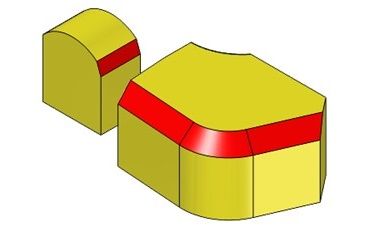April 30, 2018
Siemens PLM Software updates Parasolid with Parasolid Version 30.1. Here are some release highlights.
Parasolid v30.1 delivers enhancements across classic B-rep functionality to enable application developers to code and maintain sophisticated functionality more effectively for end-users. Facet B-rep enhancements cover complex modeling with facet data and repair of imported facet data, in addition to architectural foundations to support fully integrated Convergent Modeling in future releases. Enhancements include the following:
Blends and Booleans
- Chamfer blend functionality is enhanced to support apex-range chamfer blends in both edge and face blending with constant ranges and angles. No specific edge selection is required and control is provided for chamfer angle and offset distance.
- Improved controls to support face blend preview.
Model Editing and Interrogation
 The top faces (blue) and parallel underlying faces (not visible) are dependently offset from a lower face (red). Image courtesy of Siemens PLM Software.
The top faces (blue) and parallel underlying faces (not visible) are dependently offset from a lower face (red). Image courtesy of Siemens PLM Software.A number of classic B-rep operations have been added to enable application developers to manage end-user workflows more easily, including creation of general wire bodies, perspective outlines and symmetric periodic B-curves; mass properties of transformed topologies including reflections; improved diagnostics for swept tool and fill hole; and increased case coverage in tapering when creating mitre faces.
Facet Enabled Modeling
A large number of specific, advanced classic B-rep operations have been enhanced to operate on facet B-rep geometry, including what follows:- enhanced mesh blending and deleting chains of blends;
- modeling operations such as performing dependent offsets, sewing, transforming faces, tapering faces, deleting faces and creating isocline taper surfaces from polylines;
- Boolean edge-edge matching and Euler operations; and
- intersections between facet B-rep faces and classic B-rep planes in addition to clashes between facet B-rep and classic B-rep entities.
Mesh-Specific Enhancements
Several enhancements have been added that are specific to working with mesh data including:- returning sets of sharp mfins, indicating creases in a mesh surface. Creases are also returned as a new line type in rendering;
- faceting general facet bodies, including output of connectivity information which is of particular use in CAE applications;
- repair of tolerant slits between disjoint meshes in order to easily unite fragmented meshes into a single mesh;
- improved performance, including better caching, for meshes with many facets.
- Embedded mesh data in XT files; and
- incremental faceting of facet B-rep models.
Sources: Press materials received from the company.
Subscribe to our FREE magazine, FREE email newsletters or both!
About the Author
DE’s editors contribute news and new product announcements to Digital Engineering.
Press releases may be sent to them via [email protected].







 Examples of apex-range chamfer blends. Image courtesy of Siemens PLM Software.
Examples of apex-range chamfer blends. Image courtesy of Siemens PLM Software.